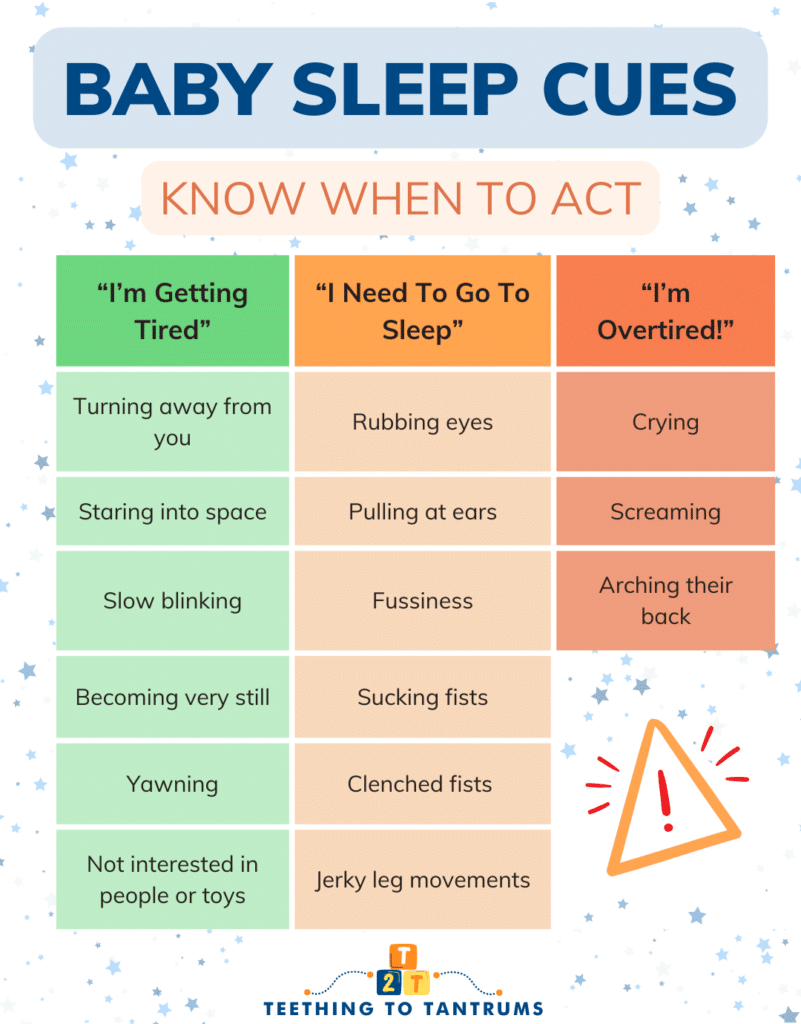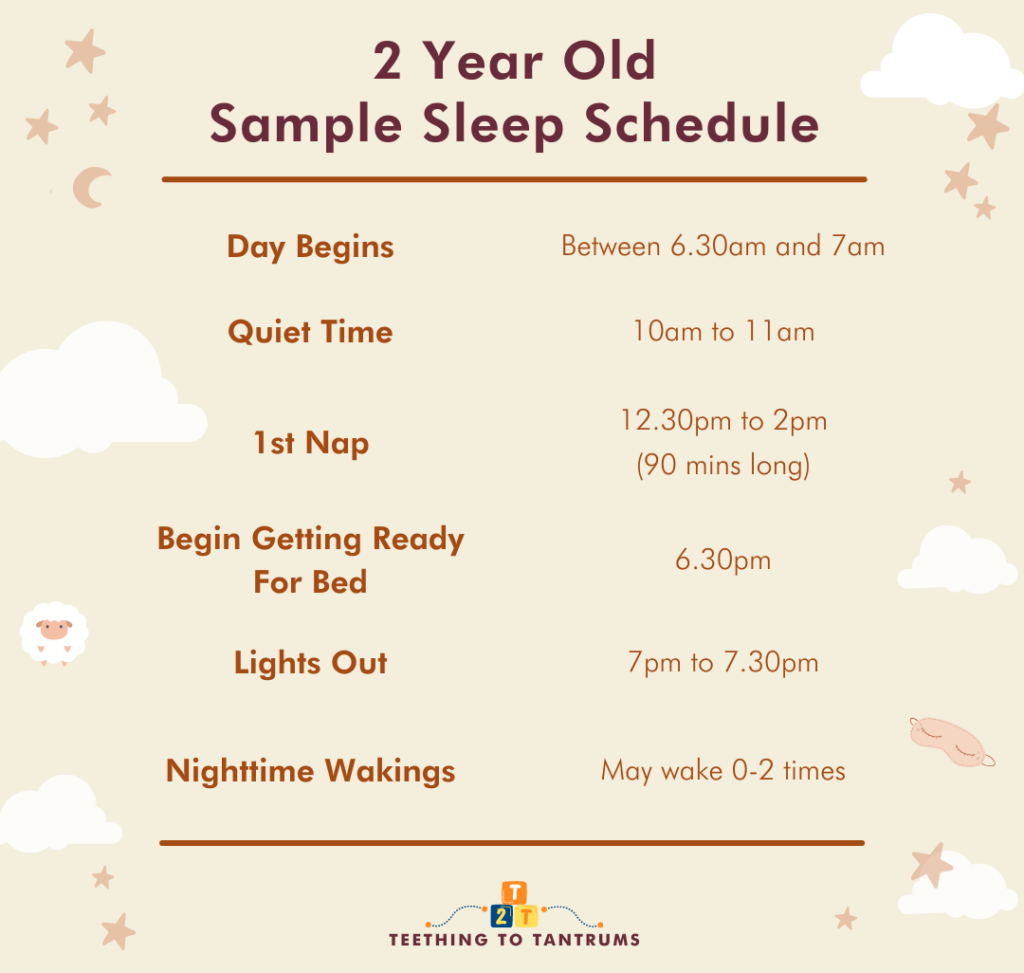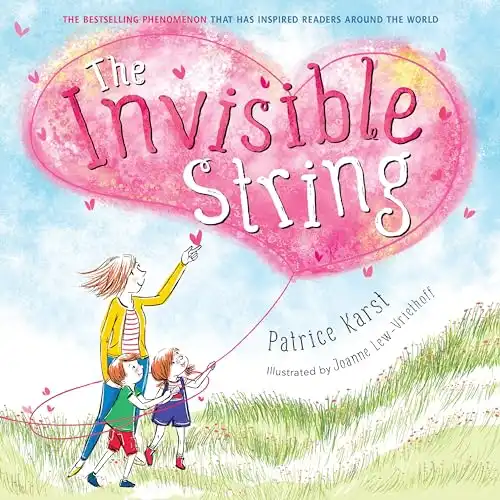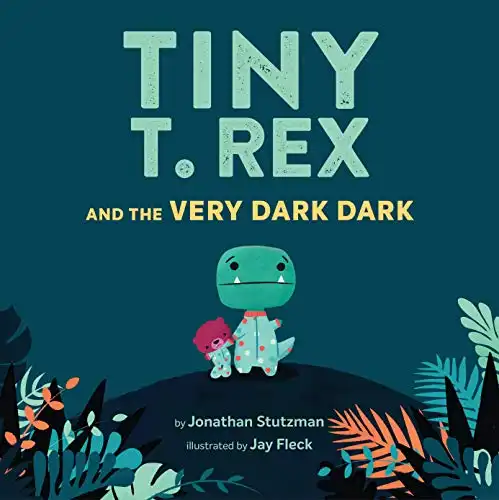When your 2-year-old refuses to nap, it can be frustrating and concerning.
You can see they are tired, but why won’t they sleep?!
You fear the worst for your afternoon activities and even more so for the bedtime battles that will follow if your 2-year-old won’t go to sleep now…
But what can you do?
Fortunately, there is a lot you can do to help your toddler sleep at nap time again.
After 40 years working as a Norland Nanny, I have seen it all, so here are my tried and tested techniques to help your 2-year-old get the rest they need to thrive.

Table of Contents
Key Takeaways
- Common reasons a 2-year-old refuses to nap include desiring independence, going through a sleep regression, becoming overtired, experiencing stress/anxiety, getting overstimulated, or having irregular routines.
- Strategies to get a 2-year-old to nap again involve creating a consistent, calming pre-nap routine, using motivational tools like reward charts, and providing a comfortable nap environment.
- If your toddler won’t nap, quiet time can be an alternative to get them to rest. But naps remain important for development, so be patient in reestablishing healthy sleep habits.
Why Your 2-Year-Old Refuses To Nap
If your 2-year-old refuses to nap, you need to know that you’re not alone.
Toddler sleep resistance is incredibly common and I have yet to come across a family whose toddler hasn’t had a blip in their sleep between the ages of 2 and 5.
Various behavioral and developmental reasons can trigger a refusal to nap and once you identify the cause, then you can decide the best course of action to help your 2-year-old sleep well again:
1. Desire for Independence
If a newfound desire for independence has recently made itself known… your toddler will try to assert their independence at sleep times and refuse to comply with your routines.
They will try and use delaying tactics by saying they need to read another book, that they need to say good night to Teddy, and that they need to drink some milk before they will sleep.
To combat this flexing of the independence muscles, give your 2-year-old some control over their daily lives.
Offer two acceptable choices during play, allow them to choose 2 books to read at naptime, or let them decide which pajamas to wear to bed to allow your little one a sense of control within your boundaries.
This will help to maintain your routines but acknowledge their growth too.
2. Sleep Regression
The 2-year-old sleep regression is one of the most common triggers for irregular sleep.
Affecting both nighttime sleep and daytime naps, a sleep regression will make it hard for your toddler to fall asleep, stay asleep, and stick to a sleep routine.
If you suspect a regression is the cause of your 2-year-old’s refusing to nap, then consistency and patience will be your best action plan to wait for this phase to pass.
For more help and useful tips on how to manage a sleep regression take a look at my post: Navingating The 2-Year Sleep Regression
3. Overtiredness
If not managed correctly, overtiredness can easily spiral out of control leading to an overtiredness cycle that is very hard to break free from.
To prevent this from happening look out for overtiredness signs like clingyness, whining and not wanting to eat. Watch for your 2-year-old’s sleep cues and act on them quickly.

REMEMBER: Even though a sleep schedule is important to maintain, if your toddler is tired, DO NOT keep them awake until their scheduled nap. Doing so will only backfire as your toddler will become overtired and be very hard to settle to sleep.
4. Stress or Anxiety
If your little one is experiencing stress or separation anxiety, you will need to take measures to reassure and help them overcome their worries.
Separation anxiety and stress can be triggered by new fears and changes in routine like moving houses, starting daycare, a fear of the dark, or the arrival of a sibling.
To alleviate nighttime worries, create a consistent and calming bedtime routine. A bath, bedtime stories, cuddles, and reassurance will all help your toddler feel safe and secure.
Try providing your little one with comfort items like stuffed animals and blankets too.
Finally, gradually build up your 2-year-old’s independence by spending brief periods apart during the day. Have trusted family members spend time with your little one away from you and read books about common worries and fears to allow your toddler to discuss their feelings with you.
|
Primary Rating:
4.9
|
Primary Rating:
4.6
|
Primary Rating:
4.5
|
|
Description: The Invisible String is a heartwarming and comforting book that helps children understand that even when loved ones are far away, they are still connected by an invisible string of love. I love this concept as it's exactly what I taught my son when we moved to the UK from South Africa. With its gentle message of love and connection, this beautifully illustrated book is perfect for children who may be struggling with separation anxiety or missing someone special. |
Description: Join Orion on an imaginative adventure through the world of the dark! In this beautifully illustrated children's book, author Emma Yarlett explores the concept of fear and how we can overcome it. Follow Orion as he learns to face his fears and discovers the magic and wonder that can be found in the dark. With engaging storytelling and stunning illustrations, "Orion and the Dark" is a must-read for children and parents alike. |
Description: Tiny T-Rex and the Very Dark Dark is a delightful and relatable book that helps children overcome their fear of the dark. Through the lovable character of Tiny T-Rex, children will learn that even the bravest of us can feel scared sometimes and that it's okay to ask for help! With its charming illustrations and empowering message, Tiny T-Rex and the Very Dark Dark is a must-read for any toddler who needs a little extra courage at bedtime. |
The Invisible String is a heartwarming and comforting book that helps children understand that even when loved ones are far away, they are still connected by an invisible string of love. I love this concept as it's exactly what I taught my son when we moved to the UK from South Africa. With its gentle message of love and connection, this beautifully illustrated book is perfect for children who may be struggling with separation anxiety or missing someone special.
Join Orion on an imaginative adventure through the world of the dark! In this beautifully illustrated children's book, author Emma Yarlett explores the concept of fear and how we can overcome it. Follow Orion as he learns to face his fears and discovers the magic and wonder that can be found in the dark. With engaging storytelling and stunning illustrations, "Orion and the Dark" is a must-read for children and parents alike.
Tiny T-Rex and the Very Dark Dark is a delightful and relatable book that helps children overcome their fear of the dark. Through the lovable character of Tiny T-Rex, children will learn that even the bravest of us can feel scared sometimes and that it's okay to ask for help! With its charming illustrations and empowering message, Tiny T-Rex and the Very Dark Dark is a must-read for any toddler who needs a little extra courage at bedtime.
5. Overstimulation
If your toddler is having regular meltdowns, chances are they are overwhelmed, overstimulated, and full of cortisol and adrenaline (the stress hormones that keep your body in a state of ‘fight or flight’).
The presence of these hormones will keep your toddler in a state of alertness, despite them being utterly exhausted. Cue the meltdowns and the reason why your 2-year-old refuses to nap. As a result, regular downtimes during the day are important for toddlers.
If you find your 2-year-old really does not want to nap, allow them to spend some quiet time in their sleep space where they can relax and reset for the rest of the day.
This downtime will help to prevent overtiredness and overstimulation.
REMEMBER: While naps are challenging, they still remain a very essential part of your toddler’s development and should not be skipped.
6. Irregular Routines
If naps are not going well the chances are that bedtime will be impacted too. To help maintain your 2-year-old’s sleep cycles, do you have a solid regular bedtime routine in place and are you doing a shorter version of this as a pre-nap routine?
If not, start establishing strong healthy associations in the lead-up to both daytime and nighttime sleep.
I cannot emphasise enough how important it is to maintain an age-appropriate consistent sleep schedule which includes a consistent and regular nap and bedtime routine as this can help mitigate nap resistance and ensure your little one gets the rest they need.
A bedtime & nap cheat sheet so good your little one will ask you to put them to bed...
Laura Williams "This is a life saver! I'm so glad I downloaded your bedtime & nap cheat sheet. My little one actually asked me to put him to bed last night! Unbelievable! Thank you so much!"
Click Here For The FREE Cheat Sheet
How To Get Your 2-Year-Old To Nap
Now you know the reasons WHY your 2-year-old refuses to nap, you can start to put plans in place to help them sleep peacefully once again.

- Developing a consistent pre-nap routine will significantly improve your toddler’s naptime success. Just as with bedtime, a fixed sequence of calm activities, such as reading a book, singing a lullaby, having a cuddle, and listening to soft music, will all signal to your child that it’s time to wind down.
- Aim to put your 2-year-old down for a nap at the same time every day, even on weekends, to regulate their internal clock. TOP TIP: If your 2-year-old refuses to nap, your priority should be to focus on getting their sleep back on track. If that means canceling a few plans on the weekend and ensuring you can offer quiet time and nap time regularly, it will be worth it in the long run.
- If your toddler still refuses to nap, then your go-to should be quiet time instead. Don’t let them stay up. Quiet time is better than nothing and often they will drop off to sleep anyway. Allowing quiet time as a substitute can take the pressure out of having to sleep, so encourage your toddler to stay in their bed or crib and read some books or play quietly on their own.
- A consistent routine fosters a sense of security and expectation, which is essential for toddlers and helps them understand when it’s time to rest. If you give in once… you will be back to square one!
- I always advise parents to have realistic expectations and not expect things to happen immediately. It can take some time for new sleep habits to take hold, but the more patient you are, the quicker your 2-year-old will get back into a healthy sleep routine.
- Creating a comfortable nap environment is key to encouraging your child to fall asleep more easily. The crib or bed should be a cozy and inviting space, with a favorite blanket or stuffed animal if they have one. You should reduce stimuli in the room, ensuring it’s dimly lit and at a comfortable temperature for sleeping. Use blackout blinds or a toddler nightlight if necessary and use a white noise machine or play some soft music to help them settle.
- Have clear incentives and cues. Motivational reward charts can help your 2-year-old feel motivated to sleep, especially if you promise to do something special once they wake from a nap, having settled nicely. You can also use a toddler OK-to-wake clock so your 2-year-old has a visual cue (usually a red or green light) to indicate when it’s time to wake up from their nap.
When it's establishing a bedtime and wake up routine, clarity can make a world of difference. And LittleHippo's Mella has done exactly that.
Using colors and cute facial expressions to signal to children when it's time to sleep and wake, even children as young as 2 can learn when it's ok to get out of bed.
Mella is not just a sleep trainer either, it also works as a timer for various daily activities such as quiet time and screen time making it a wonderfully versatile tool.
Made of child-safe materials, this clock will withstand many accidental falls ensuring longevity and peace of mind from your purchase.
I love the LittleHippo Mella, that's why it's number 1 on my list.
- Simplifies sleep training with clear visual cues
- Features 3 soothing sounds and 6 night light colors to choose from
- A cute design that suits any room decor and matches your toddler's fun-loving personality
- Has a child-lock function to prevent children fiddling with the settings
- It is a touch pricier than other ok to wake clocks
- It is not battery operated so does require a power outlet
- Some parents have reported it was slightly hard for their children to use
What Time Should 2-Year-Old Toddlers Take A Nap?
Most 2-year-olds do best with a nap starting between 12:30 PM and 1.30 PM and even though the length of the nap can vary, an hour or two is usually sufficient.
But you should not let your toddler nap for more than 3 hours as it will interfere with bedtime, so don’t be afraid to wake them if they are sleeping for too long.
Having a nap schedule will help your toddler settle more quickly and a consistent routine helps regulate their sleep patterns and supports overall wellbeing.
Here’s what a 2-year-old’s nap schedule can look like:

How Much Sleep Do Toddlers Need
On average, 2-year-old toddlers require 11 to 13 hours of sleep every 24 hours.
This total includes nighttime sleep as well as naps during the day. Therefore, you need to look at the big picture when calculating whether your child is getting enough sleep.
Some children may need slightly more or slightly less sleep, depending on their individual needs, personality, and daytime activities.
How Long Should A Toddler’s Nap Be?
When considering how long your toddler should nap for, you will need to take into account their age, how well they have slept at night, what time they wake in the morning, and what time they go to bed, as well as what has been going on in their day…
But typically, a single afternoon nap lasting 1 to 3 hours is sufficient.
This length, together with their nighttime sleep, helps your child reach the total amount of sleep needed for their age.
It’s important to note that too much daytime sleep may lead to problems at night, so getting the balance right is crucial.
Don’t be afraid to wake your toddler from their nap to ensure they are ready for bedtime when it comes around. Your 2-year-old should be awake for 4-5 hours before lights out at bedtime.
If you find that your toddler is not ready for sleep at bedtime or they are not sleeping well at night, you may need to take a look at adjusting the timing and length of the daytime nap.
NOTE: If you are tempted to shift bedtime later to accommodate your toddler’s nap time… keep in mind that doing so may impact the quality of your toddler’s nighttime sleep and their wake-up time in the morning.
Frequently Asked Questions About Toddlers Who Refuse To Nap
Understanding how to manage your toddler’s naptime struggles is crucial to ensuring they get enough rest. This section answers common questions that you may encounter as your 2-year-old navigates through changes in their sleep patterns.
Q: Why is my toddler fighting naptime even when tired?
A: Your toddler may resist naptime even when tired due to newfound independence and a desire to explore. They may also be experiencing developmental milestones that can disrupt their usual routine. It is important to maintain a consistent sleep schedule and create a calming pre-nap routine to encourage naptime. You will need to work through the resistance and offer lots of support and comfort to encourage your little one to nap when they need to. Allow them to experience more independence at other points in the day so that they don’t choose bedtimes as a battleground.
Q: How can I get my 2 year old to take a nap when they refuse?
A: When your 2-year-old refuses to nap, offer a quiet time instead, allowing them to rest in their room with minimal stimulation. Not putting pressure on them to fall asleep can often do the trick and promise them something exciting to look forward to after nap time if they stay quietly in their room for a while. Some toddler clocks have a nap function which can also help.
Q: What are common signs of a sleep regression in a 2-year-old?
A: Signs of sleep regression in a 2-year-old may include increased resistance to naptime, frequent nighttime awakenings, and overall crankiness due to fatigue. They may also show decreased appetite and changes in daytime behavior. Sleep regressions are usually temporary.
Q: Is it normal for a 2-year-old to suddenly stop napping?
A: It is relatively normal for a 2-year-old to have inconsistent napping patterns, including suddenly refusing to nap or sometimes needing to nap on some days and not on others. While it can indicate a transition from napping to quiet time, it can also be a phase. Most children continue to benefit from napping at 2 years old and that is why it is important to offer it. You may find that quiet times turn into nap times when they are given the chance to wind down and be calm.
Q: How should I adjust my toddler’s sleep schedule when they resist napping?
A: If your toddler resists napping, you could consider adjusting nap times by either moving them earlier or later in the day or dropping a nap if they are still having two. However, ensure that your toddler is not napping too late in the afternoon as this can interfere with nighttime sleep.
Q: What can I do if my 2-year-old wakes up crying in the middle of the night?
A: If your 2-year-old wakes up crying, comfort them swiftly and quietly to avoid fully waking them. Check for any immediate needs like a diaper change or thirst, then resettle your toddler and leave the room promptly. There is a chance that your toddler may be experiencing night terrors or nightmares and there are things you can do to help calm your little one if this is the cause.
Read these posts to learn how:
- Toddler Nightmares: 6 Tricks To Prevent Them From Happening
- Night Terrors In Toddlers: Don’t Panic! Do These 7 Things.
Need More Parenting Help?
- Download our FREE Bedtime & Nap Sleep Cheat Sheet. It’s a free, easy-to-use and proven formula designed for parents of 0-5 year olds to master the art of consistently undisturbed and restful sleep without the yelling, nagging or exhausting long-winded evenings.
- Check out our Parenting Toolbox. You’ll get access to expertly-chosen products that you can guarantee are the best for your little one and your wallet.
- Are you looking for personalized guidance to navigate the challenges of parenting? I offer 1-on-1 consultations to bring you tailored strategies and actionable advice to help support your child's growth and well-being with confidence.

A bedtime & nap cheat sheet so good your little one will ask you to put them to bed...
Laura Williams "This is a life saver! I'm so glad I downloaded your bedtime & nap cheat sheet. My little one actually asked me to put him to bed last night! Unbelievable! Thank you so much!"
Click Here For The FREE Cheat Sheet






